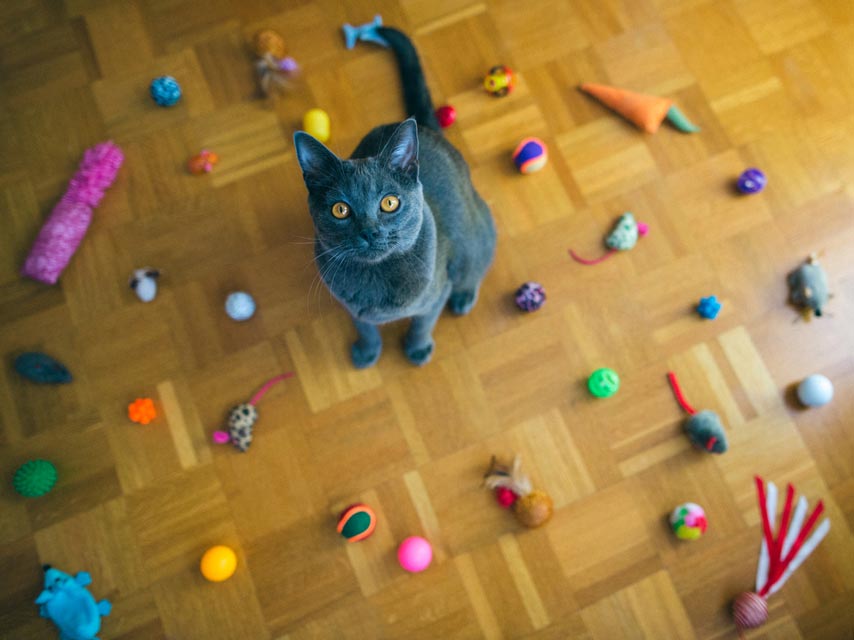Can Special Playtime Decrease Problem Scratching?

When we talk about problem cat scratching, one thing that usually comes up is feline stress. Stress in cats often leads to increased scratching behavior because cats feel calmer when they are able to mark their territory and physically blow off some steam with aggressive scratching.
Stress relief techniques for cats can include using Feliway diffusers and sprays and increasing the cat's "resources" in the home by adding more litter boxes, food bowls, cat beds, and scratching posts. Another crucial element for stress management is providing opportunities for play that simulates hunting for the cat.
Interactive Play That Allows Cats to "Hunt" Is Ideal
Interactive play, or play where you use a toy to simulate prey behavior and allow your cat to pretend to be the hunter and chase, pounce, and "kill" it, is a crucial element in maintaining cats' mental and physical health. Pent-up predator instincts with no outlet can be quite stressful for a cat that lives indoors and doesn't get much of a chance to chase rodents or birds.
You will need some interactive toys that can be made to simulate a bird's or rodent's activity. These generally include a firm wand portion for you to hold onto, a rod, and a toy on the end that usually has a feather or some other type of wispy quality to it.
When you are using a wand toy to simulate a cat's prey, you should always keep in mind how chased prey acts around a predator and make the wand toy act like that. For instance, prey rarely runs toward a predator, so you should not make the wand toy moved toward the cat. Always have the toy moving away from the cat, but it should also act like scared prey does by freezing occasionally, darting behind and underneath things, and moving in a zigzag pattern as it "runs" or "flies" away from the cat.
Should You Let Your Cat "Win" the Game of Predator-Prey?
You should always let your cat catch the "prey" sometimes. A hunter that is unable to catch prey is a pretty depressed creature. You don't want to add any stress to your cat's life by creating a situation where he believes he's never able to catch his prey.
Make sure you allow your cat to catch the wand toy periodically, but don't make the game too easy. And you should always let the kitty catch the prey at the end of the playtime. You may even wish to have a throw toy in your pocket so the game can end with your cat having a nice tussle with his "prey," pouncing on it, bunny-kicking it, and biting it. After he's done, give him a nice, tasty treat or some food because when a hunter is done with his kill, he gets a meal.
You will probably notice that after an interactive play session, once you have fed your cat and he's eaten his meal, he will groom himself and then take a long nap. This is normal predator behavior. In the wild, cats expend a lot of energy hunting prey, then they have a meal, and then they sleep for good long while to build up their energy stores.
You should aim for at least one 10-minute play session per day with your cat, using interactive toys. More is better, but you should strive not to have less playtime than that.
Tips and Tricks for Keeping Your Cat Engaged with His Toys
In order to keep your wand toys from becoming uninteresting to your cat, be sure to do the following:
- Put the toys away at the end of the play session. If you don't, they are simply sitting there being dead prey for your cat, and he won't appreciate them suddenly coming back to life for a new play session.
- You should always put the wand toys away, also, because they can be unsafe for your cat to play with unsupervised. The rope portion of the wand toy can become tangled around your cat's neck or paws if he tries to play with it by himself, and that can be quite dangerous.
- Keep a variety of toys in a box where your cat can't get to them, and bring different ones out each time you play. This helps them stay new and interesting for your cat.
You May Also Like These Articles:
How to Decrease Fighting in Multicat Households
5 Ways to Tell If Your Cat Is Stressed (and Tips for What to Do)


